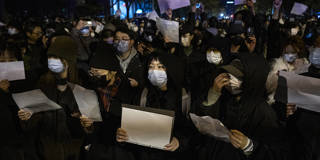In response to the COVID-19 pandemic, different countries adopted different strategies, depending on their respective cultural and historical traditions. While China's top-down authoritarian strategy initially seemed effective, the regime's zero-COVID policy ultimately proved to be fatally flawed.
BERLIN – In October, the Communist Party of China convened its 20th National Congress, primarily to confirm President Xi Jinping’s hold over the country’s leadership. Everything went according to his plan: the CPC’s top governing body, the Standing Committee, is now staffed only by his most devoted henchmen. With Xi having secured a third term as general secretary – and thus as president – one man now has absolute power in China for the first time since the days of Mao Zedong.
Gone is the principle of collective, term-limited leadership that Deng Xiaoping introduced following Mao’s death – a time when China was just beginning its massively successful modernization phase. Yet, as recent history shows, the return to one-man rule in a country of 1.4 billion people represents one of the greatest risks to China and its status as a rising superpower second only to the United States.
Yes, under Xi, the Chinese regime’s power has increasingly seemed unlimited and unrestricted, owing to massive investments in state-of-the-art digital mass surveillance and social control systems. Yet the CPC’s strength is not based only on all-encompassing “smart” repression. Rather, it is the result of the party’s tremendous successes in modernizing China.

BERLIN – In October, the Communist Party of China convened its 20th National Congress, primarily to confirm President Xi Jinping’s hold over the country’s leadership. Everything went according to his plan: the CPC’s top governing body, the Standing Committee, is now staffed only by his most devoted henchmen. With Xi having secured a third term as general secretary – and thus as president – one man now has absolute power in China for the first time since the days of Mao Zedong.
Gone is the principle of collective, term-limited leadership that Deng Xiaoping introduced following Mao’s death – a time when China was just beginning its massively successful modernization phase. Yet, as recent history shows, the return to one-man rule in a country of 1.4 billion people represents one of the greatest risks to China and its status as a rising superpower second only to the United States.
Yes, under Xi, the Chinese regime’s power has increasingly seemed unlimited and unrestricted, owing to massive investments in state-of-the-art digital mass surveillance and social control systems. Yet the CPC’s strength is not based only on all-encompassing “smart” repression. Rather, it is the result of the party’s tremendous successes in modernizing China.